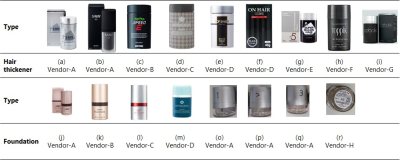S5
MRI Safety for Leave-on Powdered Hair Thickeners: Measurement of Deflection Force and MRI Artifact1Radiological Technology, Gunma Prefectural College of Health Sciences, Maebashi, Japan, 2Radiology, Kiryu Kosei General Hospital, Kiryu, Japan, 3Graduate School of Radiological Technology, Gunma Prefectural College of Health Sciences, Maebashi, Japan, 4Radiology, Gunma University Hospital, Maebashi, Japan, 5Isesaki Municipal Hospital, Isesaki, Japan
Synopsis
The purpose of this study was to evaluate the attraction force and image artifacts of 17 different leave-on powdered hair thickeners from 7 vendors. Displacement force was measured by the ASTM F2052, and MRI artifact was estimated by the ASTM F2052. There were some types of leave-on powdered hair thickener that do contain magnetic materials. They were highly susceptible to mechanical effects and will cause more image artifacts, so it must be removed before the examination.
Background
In recent years, more and more people are using leave-on powdered hair thickeners instead of wigs to treat thinning hair. The number of vendors and types of leave-on powdered hair thickeners has been increasing rapidly. Sneha et al. reported a case in which sprinkled a leave-on powdered hair thickener caused significant image artifacts [1], but there is no detailed study on the mechanical effects and image artifacts of various leave-on powdered hair thickeners. The purpose of this study was to evaluate the attraction force and image artifacts of 17 different leave-on powdered hair thickeners from 7 vendors.Methods
Seventeen types of leave-on powdered hair thickeners from seven vendors were included in the study. Nine of them were hair thickener types, and 8 were foundation types (Fig. 1). We used a 1.5 Tesla MRI system (Ingenia 1.5T,Philips electronics) and a 3 Tesla MRI system (MAGNETOM Skyra, Siemens) to measure the displacement force using the method described in ASTM F2052 [2]. After measuring 10 g of each powder, the magnetically induced deflection force was calculated using the mean deflection angle. MRI image artifacts were evaluated based on the method described in ASTM F2119 [3]. MATLAB 2020b (Mathworks) was used to analyze the image artifacts. All samples and a reference water sample were sealed in a plastic container. The containers were sealed in an MRI sample measurement phantom (90–401 type, NIKKO FINES). The phantom obtained T1-weighted images by spin-echo sequence and T2 star-weighted images by gradient-echo sequence using a 1.5-tesla MRI system and 3-tesla MRI system. From the MR images of each sample obtained by each sequence, the area where the presence of the sample caused a signal change of 30% or more compared to the image without the sample was measured (ΔS[%]).Results
The deflection angle of all eight hair thickener types was 0 degrees, and there was no mechanical effect on the change force measured by ASTM F2052. On the other hand, for the foundation type, the deflection angle of five samples was 90 degrees except for samples o, p, and q, and was strongly affected by mechanical effects. No artifacts appeared in the MR images of the hair thickener type samples even when all the samples were imaged on the 1.5 Tesla MRI system and the 3 Tesla MRI system. On the other hand, significant artifacts were observed on both MRI systems and sequences for all foundation type samples except for samples o, p, and q. The ΔS according to ASTM F2119 was less than 13% in the images obtained from the 1.5 Tesla MRI system and less than 7% in the images obtained from the 3 Tesla MRI system for the hair thickener type. On the other hand, for samples j, k, l, m, and r, the percentage was more than 79% in the images obtained from the 1.5 Tesla MRI system and more than 63% in the images obtained from the 3 Tesla MRI system.Conclusions
Leave-on powdered hair thickener looks similar, but there are several suppliers and two types of hair thickening type and foundation type. There are many types of leave-on powdered hair thickener that do not contain magnetic materials. At the same time, there are also some types of leave-on powdered hair thickener that do contain magnetic materials. The leave-on powdered hair thickener that contains magnetic material is highly susceptible to mechanical effects and will cause more image artifacts, so it must be removed before the examination. The MRI technologist should check the type of powdered hair thickener before the examination and take appropriate action if necessary.Acknowledgements
No acknowledgement found.References
[1] Chenji S, Wilman AH, Mah D, Seres P, Genge A, Kalra S. Hair product artifact in magnetic resonance imaging. Magn Reson Imaging 2017;35:1-3.
[2] ASTM F2052-15, Standard Test Method for Measurement of Magnetically Induced Displacement Force on Medical Devices in the Magnetic Resonance Environment, ASTM International, West Conshohocken, PA, 2015, www.astm.org.
[3] ASTM F2119-07(2013), Standard Test Method for Evaluation of MR Image Artifacts from Passive Implants, ASTM International, West Conshohocken, PA, 2013, www.astm.org.
Figures




